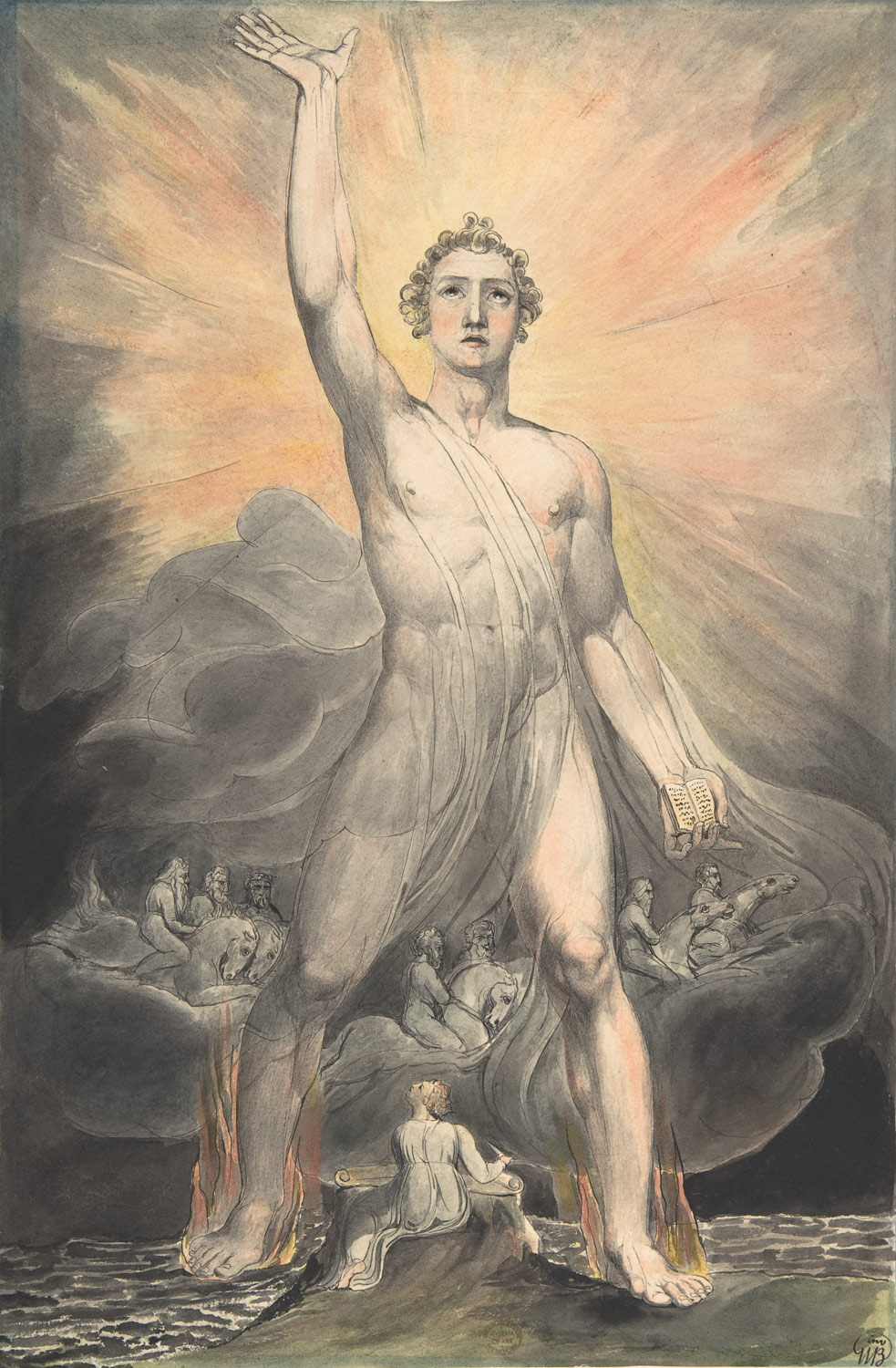Satiric Verses and Epigrams, (E 514)
"Rafael Sublime Majestic Graceful Wise
His Executive Power must I despise
Rubens Low Vulgar Stupid Ignorant
His power of Execution I must grant"
 |
| Metropolitan Museum of Art Angel of Revelation 1805 Signature bottom right |
Blake's ability to invent was recognized by his contemporaries, but they sometimes denied his ability to execute which depended upon different skills. Blake would not concede that his ability to execute was any less than his ability to invent.
Blake's training was as a reproductive engraver whose skill is faithfully reproducing images which have been conceived by others for printing in published form. Since his goal was to execute his own inventions, not just the inventions of others, he developed a broad set of skills encompassing disciplines which spanned visual and verbal communication. Engraving in the conventional practice became his vocation; his imaginative creations became his art which he considered to be the 'whole business of man.'
Blake's ability to execute was dependent on a two pronged method of learning: study of his predecessors and experimentation. He found in Michelangelo the finest ability to conceive and execute so he set him up as a model in art, as he did Milton in poetry. His experimentation led him into novel methods of printing, painting and writing. Learning through experiments was another facet of his inventiveness; gaining mastery of his new methods allowed him to execute his images in an individualistic manner. If his aim had been to follow current trends and appeal to popular tastes he would have applied different strategies.
Invention and Execution became for Blake two of his contraries; two opposed but equally true expressions of the unity of his art. His work was in consolidating the inner dimension - the invention, with the outer expression - the execution. If they were not perfectly balanced, the work of art would be spoiled by failing to communicate Eternal truth.
Public Address, Page 60, (E 576)
"No Man Can
Improve An Original Invention. [Since Hogarths time we have
had very few Efforts of Originality] but
Drawn with a firm
hand at once [with all its Spots & Blemishes which
are beauties & not faults] like Fuseli & Michael Angelo
Shakespeare & Milton>" Public Address, PAGE 62, (E 576)
"I have heard many People say Give me the Ideas. It is no
matter what Words you put them into & others say Give me the
Design it is no matter for the Execution. These People know
Nothing Of Art. Ideas cannot be Given
but in their minutely Appropriate Words nor Can a Design be made
without its minutely Appropriate Execution ... He who copies does
not Execute he only Imitates what is already Executed Execution
is only the result of Invention"
Public Address, Page 24, (E 582)
"I know my Execution is not like Any Body Else I do not
intend it should be so
...I defy any Man to Cut
Cleaner Strokes than I do or rougher when I please & assert that
he who thinks he can Engrave or Paint either without being a
Master of Drawing is a Fool Painting is Drawing
on Canvas & Engraving is Drawing on Copper & nothing Else
[Drawing is Execution & nothing Else] & he who Draws best must be
the best Artist [&] to this I subscribe"
Annotations to Reynolds, P iii, (E 637)
"Invention depends Altogether upon Execution or
Organization. as that is right or wrong so is the Invention
perfect or imperfect. Whoever is set to Undermine the Execution
of Art is set to Destroy Art Michael Angelos Art Depends on
Michael Angelos Execution Altogether"
Annotations to Reynolds, p 126, (E 654)
"Can any Man be such a fool as to believe that Rafael &
Michael Angelo were Incapable of the meer Language of Art & That
Such Idiots as Rubens. Correggio & Titian Knew how to Execute
what they could not Think or Invent"
Descriptive Catalogue, (E 528)
"If Italy is enriched and
made great by RAPHAEL, if MICHAEL ANGELO is its supreme glory, if
Art is the glory of a Nation, if Genius and Inspiration are the
great Origin and Bond of Society, the distinction my Works have
obtained from those who best understand such things, calls for my
Exhibition as the greatest of Duties to my Country."
Descriptive Catalogue, (E 547)
"...when the Artist took his pencil, to execute his
ideas, his power of imagination weakened so much, and darkened,
that memory of nature and of Pictures of the various
Schools possessed his mind, instead of appropriate execution,
resulting from the inventions; like walking in another man's
style, or speaking or looking in another man's style and manner,
unappropriate and repugnant to your own individual character;
tormenting the true Artist, till he leaves the Florentine, and
adopts the Venetian practice, or does as Mr. B. has done, has the
courage to suffer poverty and disgrace, till he ultimately
conquers."
.








